| Srl | Item |
| 1 |
ID:
167468
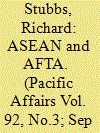

|
|
|
| 2 |
ID:
141737


|
|
|
|
|
| Summary/Abstract |
In recent years, financial cooperation within ASEAN Plus Three (APT) has made significant progress. It has covered bond market development, better access to financing, financial stabilization and capital market harmonization, and several initiatives have resulted in concrete programmes being implemented by the APT member countries (ASEAN states, China, South Korea and Japan). In the context of the changes taking place in the regional dynamic, this paper examines the role and involvement of Indonesian financial authorities towards the development of APT financial regionalism, focusing on issues related to regional liquidity arrangements and regional bond markets. The initial findings indicate that, in considering the potential benefits of warding off future economic shocks, there is a strong intention among Indonesian financial authorities to create a space in their national framework for regional liquidity arrangements. However, the authorities are unenthusiastic about the progress of regional governance on bond markets and, for that reason, are disinclined to transform their national regulatory space as it potentially hampers the Indonesian domestic market.
|
|
|
|
|
|
|
|
|
|
|
|
|
|
|
|
| 3 |
ID:
055707
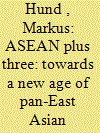

|
|
|
| 4 |
ID:
089515
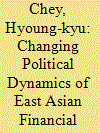

|
|
|
|
|
| Publication |
2009.
|
| Summary/Abstract |
This paper analyzes the factors that have contributed to the development of the Chiang Mai Initiative, one of the prominent examples of recent East Asian financial cooperation, by comparing it with the failed 1997 proposal for an Asian Monetary Fund
|
|
|
|
|
|
|
|
|
|
|
|
|
|
|
|
| 5 |
ID:
120633
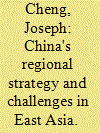

|
|
|
|
|
| Publication |
2013.
|
| Summary/Abstract |
China has rapidly developed a sophisticated regionalism strategy in East Asia. Minimising the region's "China threat" perception has been a significant consideration in this strategy. Unfortunately, the ongoing escalation of tension concerning territorial disputes over the Diaoyutai / Senkaku Islands and the South China Sea, initiated by a series of high-profile naval exercises in the latter half of 2010, has reinforced the "China threat" perception and bolstered the hedging strategies of countries in the region. China is aware of its relative disadvantage, and it has been keeping its options open while allowing ASEAN to maintain the initiative.
|
|
|
|
|
|
|
|
|
|
|
|
|
|
|
|
| 6 |
ID:
097228
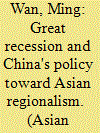

|
|
|
| 7 |
ID:
083744
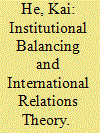

|
|
|
|
|
| Publication |
2008.
|
| Summary/Abstract |
This study integrates elements of neorealist and neoliberal theories with a model of institutional balancing that identifies the conditions under which this form of soft balancing occurs. Institutional balancing, i.e. countering pressures or threats through initiating, utilizing, and dominating multilateral institutions, is a new realist strategy for states to pursue security under anarchy. The interplay between the distribution of capabilities and strong economic interdependence shapes states' decisions on when and how to employ this strategy. Historical examples include: inclusive and exclusive efforts by Third World states and the superpowers to organize voting blocs in the UN during the Cold War; inclusive institutional balancing of ASEAN states to constrain China and ensure US support in the ASEAN Regional Forum (ARF) after the Cold War; exclusive institutional balancing of ASEAN states against the US in the ASEAN Plus Three (APT) summit after the Southeast Asian financial crisis. These examples illustrate the logic of institutional balancing under the conditions of bipolarity, incipient multipolarity, and unipolarity.
|
|
|
|
|
|
|
|
|
|
|
|
|
|
|
|
| 8 |
ID:
109474


|
|
|
|
|
| Publication |
2011.
|
| Summary/Abstract |
Although economically interdependent, political rivalry between Japan and China have brought about the inability of the Association of Southeast Asian Nations Plus Three (APT) process to transform itself into an East Asia Summit (EAS) as originally envisioned. The existence of the APT and the EAS as two separate entities not only reflected the politico-security rivalry between the two neighbours but more importantly affected the direction and progress of East Asian regionalism as a whole. Aiming to provide a historical account of the EAS process and examine Japan's role in the development of the EAS framework, this paper argues that Japan has put greater attention on the EAS and made numerous unilateral initiatives to develop it. While Japan does not seek ultimate power, it considers the EAS as an excellent opportunity to: (i) raise its influence in the region vis-à-vis China; (ii) elevate the status of the EAS in region-building and (iii) check Chinese advances by fulfilling its long-held policy of having other Asia Pacific countries, primarily Australia and New Zealand, join. Nevertheless, the decision to expand the EAS to include the USA and Russia will have some adverse effects on Japan's unilateral ambitions and the furtherance of regionalisation processes.
|
|
|
|
|
|
|
|
|
|
|
|
|
|
|
|